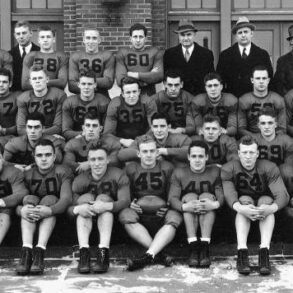College football crowned its newest national champion on Monday night, as Ohio State beat Notre Dame to become the first team to win a title in the 12-team College Football Playoff era.
As we sit here at the end of the longest season in the sport’s history, it feels like a good time to reflect on all that we’ve experienced since Labor Day weekend. We’ve learned a lot!
Here are the 12 biggest lessons I learned from the first year of the 12-team College Football Playoff:
On-campus Playoff games are awesome.
Now, this wasn’t a shocker. We knew the first-round games would be special, because the magic of college football is what we see and hear on Saturdays in college towns. All the pomp and circumstance is what separates college football from its professional counterparts. And even though the four first-round CFP games were varying levels of lopsided, the environments were electric. I’d love to see the CFP put the quarterfinal round on campus, too. It just doesn’t seem fair that the top four seeds don’t get to host — while their fans would have to pay to travel to three neutral-site games if they want to follow their team all the way to the national championship. That’s too much to ask of fans. Put at least two rounds of games on campus, please!
On-campus games a major win for 12-team CFP
Nicole Auerbach and Joshua Perry discuss why the on-campus games were a huge hit during the first 12-team College Football Playoff.
It’s nice not to write teams off after one bad September loss.
My biggest issue with the four-team CFP era was the way too many fans and media members only talked about the sport through the prism of the Playoff. And in that era, there were usually only 6-8 teams at the start of the season that had a legitimate chance to make the four-team field. We — meaning the collective college football community — essentially eliminated teams from CFP contention after early-season losses and then largely ignored them the rest of the year. I hated that, and I know so many fans who did, too. The new system allows teams to evolve and get better over the course of the season. Notre Dame knew it had zero margin for error after its loss to Northern Illinois, but it also knew that if it could turn around its season by winning out, it could prove its worth on the field in the 12-team CFP. Teams remained in Playoff contention after one loss, no matter how bad it seemed. Lots of teams remained in contention after two losses, and three-loss teams with good wins were in the mix all the way until Selection Sunday, too.
The biggest brands and/or the most talented teams will likely be the ones that reach the championship game, now that they get more mulligans.
And that’s fine. I’ve always said we’re probably going to still see the Ohio State/Alabama/Georgia types in the national title game, just like we did during the four-team CFP era, but that it’d be a more interesting path to get there. And that was certainly true in Year 1. We had one title-game participant with a September loss to a team from the Mid-American Conference and the other who picked up its second loss to its hated rival (having a rather pedestrian season to that point) in the regular-season finale. Both teams got second leases on life after what typically would have been CFP-eliminator losses. So, yeah. If the most talented team in college football underachieves in the regular season, it might still have an opportunity to get itself together and go on a tear in the postseason. That’s how you end up with a No. 8 seed winning it all despite being far from a true Cinderella. The version of Ohio State we saw in the CFP was always in there somewhere. But in other years, those Buckeyes would never have had a chance to play for a national championship.
College football fans seem to root for Goliath to crush David.
Maybe this is something that will change over the course of the 12-team CFP era. But the vitriol that Indiana (and SMU) received this fall is one thing that I’ll always remember about Year 1. There were too many pundits and fans (of SEC teams) that believed the Hoosiers and Mustangs weren’t good enough to make the 12-team field — and therefore those people wanted to see those teams get crushed in their first-round games to prove their point. The same thing happened the Boise State and Arizona State, in large part because they both received first-round byes and top-four seeds despite being ranked below a number of at-large teams by the CFP selection committee. I loved that Indiana, SMU, Boise State and Arizona State got to play in the CFP. It would have been amazing to see one of them pull off an upset, too. But when they played, it certainly didn’t feel like it does when I watch the first couple of days of March Madness. During those glorious four days, it feels like there is a groundswell of support anytime there’s a potential Cinderella. Like, we’d all rather see an upset than root for our bracket to stay perfect if it means it’s chalky. So far, it seems like college football fans would rather be proven right — even in blowout form — than root for the underdog and/or non-blueblood.
Seeding is ‘huge conversation’ after CFP results
Nicole Auerbach and Joshua Perry discuss how the seeding system could change following the inaugural edition of the College Football Playoff quarterfinals.
I’m conflicted about how much the new format impacted the regular season.
This year’s regular season was spectacular. There were tons of top-10 upsets and a lot of meaningful games in November — because so many teams were still in the hunt for the Playoff. To me, that was the CFP impacting the regular season in a positive way, and it outweighed the idea that certain regular-season results may have mattered less than if they happened in a previous season. Like, say, Northern Illinois beating Notre Dame. That result ultimately didn’t prohibit the Irish from playing for a national title. This is a sport that historically has honored the pursuit of perfection, and that meant that you couldn’t slip up even once throughout the regular season. Every Saturday needed to be treated as seriously as life or death. That’s not quite the case anymore, considering the aforementioned mulligans. But I still think the value of having more teams in the mix for the CFP down the stretch matters more to me than the idea that Northern Illinois’ win over Notre Dame didn’t eliminate the Irish from Playoff contention. The sky was still falling in South Bend after that game, by the way. Even if everyone knew that the team would likely make the CFP if it won out, it still hurt. It still mattered.
But rivalry games don’t matter quite as much.
I will concede this point. I am worried that Ohio State winning a national championship after losing to Michigan will convince people that the game itself didn’t mean anything, even though it was the fourth straight loss in a rivalry that means the world to both sides. Besides, a brawl broke out on the field after that game. Ryan Day had to hire security to protect himself and his family. You can’t tell me that the game didn’t matter! But it’s definitely possible that future iterations of that game may not feel like they’ve got the same stakes after what we just witnessed. Like, five years from now, I could see The Game feeling like it’s got less juice because it can’t deal the loser a knockout blow. I know we already lived in a world in which the loser of this game reached the four-team CFP — Ohio State, in 2022 — but there’s even more wiggle room (and more at-large teams) in the new format. I don’t want rivalry games to mean less because they’re one of the absolute best parts about college football, but I think that it’ll be up to participants of these games to make sure they remain important. Because the system itself likely won’t.
Conversations about CFP structure far from over
Nicole Auerbach and Joshua Perry discuss the upcoming February meeting between key College Football Playoff figures, where structural changes will be on the table but require unanimous support to pass.
Conference championship games are kind of useless now.
There are two main issues with conference championship games as I see it right now. The first is that the losers of the Big Ten and SEC title games received better draws in the actual 12-team Playoff bracket than the winners of those championship games. Now, we can argue about Georgia’s path in light of quarterback Carson Beck‘s season-ending injury, but I think the overall point stands. Penn State and Texas both had easier paths to the national semifinals than Oregon and Georgia did, and both the Nittany Lions and Longhorns made it to the final four. No system that wants to incentivize participation in a conference championship game would ever seek to penalize the winner of the game, and yet that is what happened because the bracket itself wasn’t balanced fairly. And why would you want to play the extra game anyway? Ohio State didn’t have to play in a league championship game. Notre Dame didn’t, either. Nor did Tennessee or Indiana. All of those teams made the field comfortably, and they got a break before the CFP.
The other big issue with these games is that, if you’re a fan, there’s no reason to attend them anymore. Why travel that round when you could save your money to go to one or more Playoff games? If you were an Oregon fan, why would you have flown to Indianapolis when you knew the Ducks would be in the field? You could have saved your money (and PTO if you needed it) for either the Rose Bowl if they won the game or a game in Eugene if they lost it. Conference championship games are valuable because they draw eyeballs and media partners pay to air them. But do fans care to go?
The CFP needs to fix its seeding issue.
This was the most glaring problem with the new format. I know the seeding rules were created all the way back when there were five power conferences that were pretty evenly matched. But now that Texas and Oklahoma are in the SEC and USC, UCLA, Oregon and Washington are in the Big Ten, we live in a world that includes two megaconferences and the Big 12 and the ACC. It’s far likelier now to have situations like the one we experienced — where there are multiple at-large teams from the Big Ten and SEC that are ranked above champions from the Big 12 and ACC as well as the highest-ranked Group of 5 champion. But because the top four seeds have to be conference champions, Boise State (at No. 3) and Arizona State (at No. 4) were seeded above teams the selection committee deemed better than them. So, the No. 1 overall seed (Oregon) drew the eighth seed that was really the sixth-best team in the field in the quarterfinal round, which wasn’t fair. And Penn State and Texas had easier paths to the semis (on paper) than the teams they lost to in their respective conference championship games. The bracket needs to be balanced; this is an issue of fairness. But it was also something that confused fans, which is also bad! Seeds should be the same as rankings.
Crowing a champion on Jan. 20 felt too late.
This was the longest college football season ever, and it felt that way by the end. This sport loses momentum after Jan. 1 — a day that is synonymous with college football — and the farther away from that date it is played, the less relevant it seems. This year’s title game was played after two rounds of NFL playoff games, and it was played the literal day after two thrilling divisional matchups (in snow!). There is such thing as football fatigue, especially when it’s a college game played on a Monday night for the first time all season and you aren’t a diehard fan of either team. ESPN announced Wednesday that the championship game averaged 22.1 million viewers. That made the game the most-watched, non-NFL sporting event over the past year, but it was also a 12 percent dropoff from the 2024 title game that featured Michigan and Washington. A double-digit decrease in viewership for a game pitting two of the sport’s biggest brands against one another is not great. It’s a product of timing, with the game falling so deep into the NFL playoff ecosystem and so many days after the semifinals, but it’s also a bit unlucky because it overlapped with the inauguration, an event that only happens once every four years and dominates the news cycle. But it felt late. It felt like it got a bit swallowed up by the NFL. It felt like an issue.
The NFL needs to help college football, its feeder system.
The NFL is king, and every other sport tries to avoid going head-to-head with such a behemoth. Because the CFP added games to the backend of its season (while including a two-week break from conference championship weekend to the first first round of the Playoff, its leaders had no choice but to put two first-round games up against NFL games on the third Saturday in December. To avoid the NFL, the CFP played its semifinals on a Thursday and Friday night. To avoid the NFL, the CFP played its championship game on a Monday night. I think it’s time for the NFL to work with college football and help it find standalone windows for its meaningful postseason games on days and in timeframes that set it up for success. College football is the NFL’s unofficial minor league system, and the NFL should try to help it succeed. Why can’t the NFL back off that third Saturday in December? Could the NFL schedule two playoff games in the afternoon but leave Saturday night open to allow for the CFP championship game? Imagine how great that would be, if college football’s championship game could be played on the day of the week it is known for. I know the NFL cares most about the NFL, but this would be a great way to support its feeder system and create even bigger stars who will then head to the pros.
What made CFP, bowl games more special this year?
Rushing the Field’s Nicole Auerbach and Joshua Perry reflect on the 2024 College Football Playoffs and popular bowl games, detailing why they meant more compared to previous seasons.
The SEC no longer runs college football. (Well, that might be an exaggeration.)
This is going to be such a fun and/or annoying offseason topic. But the SEC didn’t have a participant in the national championship game for a second straight year, and the Big Ten has now won back-to-back titles. That doesn’t mean there’s been some permanent power shift in college football, but it does create a slightly different landscape for the sport. The SEC was the deepest league this season, but it didn’t have any elite teams. The Big Ten is top-heavy, but it had three of the best teams in the country. It’s certainly possible that the SEC regains its spot atop the sport next season, as it looks to have some of the most exciting quarterbacks in the country in its footprint. But it’s also possible that the league is closer to the pack than it is head and shoulders above the other power conferences, as was the case of much of the past two decades. Now that there’s immediate eligibility for transfers and now that donors (and soon schools) can legally pay players, talent is dispersed more than it used to be. It’s harder than ever before to stockpile talent, particularly when highly touted players are riding the bench. So, great players that might have waited their turn to play for Nick Saban at Alabama years ago might now transfer to play right away at Ole Miss or Ohio State instead. With more teams making the CFP in a larger field, there are also more options for great players who might want to stay close to home or go off the beaten path — but still have a shot to make the Playoff. Those dynamics aren’t changing, either. We’ll see what happens next year, but for now the SEC is in the unusual and uncomfortable spot of looking up at the Big Ten. Again.
The new 12-team format is better than the old four-team format, which was better than the BCS, which was better than using polls to determine the national champion — or letting teams simply declare themselves national champions.
This has been a rousing success. Sure, there are tweaks and changes sure to come. But I hope those tasked with overseeing the sport don’t mess with it too much.
This post was originally published on this site be sure to check out more of their content.







